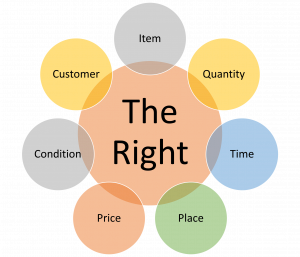2.2 Distribution Logistics
Learning Objective
1. Analyze the role of distribution logistics in value chain.
With increase in international trade over the years, Consumer expectations have changed. Now, they want goods of high quality, service, responsiveness, and flexibility. Logistics has gained attention here by providing organizations with increased efficiency and flexibility. “Companies now seek to create synergies with other organizations and begin to create value chains through horizontal and/or vertical collaboration with logistics partners (Moutaoukil. et al., 2012, p. 477). ” It helps businesses in satisfying the changing demand pattern of their consumers. Logistics can be thought as a company’s consumer-facing side that strives to add value to their consumers every day (Jejani et al., 2019).
The Council of Supply Chain Management Professionals (n.d.) define logistics as:
The part of supply chain management that plans, implements, and controls the efficient, effective forward and reverses flow and storage of goods, services and related information between the point of origin and the point of consumption in order to meet customers’ requirements (para. 5).
Additionally, international selling require companies to focus more on their distribution strategies. For instance, a developing country’s distribution strategies would require attention to loosely integrated networks, limited logistics and smaller retail markets to sell the product (Mariadoss, 2017). So, companies need to make their distribution plans different for different counties. Further, distribution becomes even more important because it makes sure that a company’s customers are highly satisfied by making it necessary for companies to provide the desired quality and quantity of products to the value chain customers (Klumpp & Heragu, 2019).
Did You Know?
- How Nokia Tackles Distribution Challenges?
- This example will help you understand how companies change their distribution strategies for different countries.
Nokia is a $26 billion company with over 92,000 employees (Nokia Corporation, 2020). It sells 150 different devices, of which 50 to 60 are newly introduced each year. Each device can be customized on many variants, including language and content. This variation adds greatly to the devices’ complexity; three hundred to four hundred components need to arrive on time at factories in order for the devices to be built. Approximately one billion people use Nokia devices worldwide. Countries like China, India, and Nigeria, which ten years ago had almost zero penetration of mobile phones, now have twenty million to forty million users each. Emerging markets now account for over half of Nokia’s annual sales.
Nokia has the challenge of selling a growing variety of mobile devices in hundreds of thousands of tiny retail outlets in the developing world. To tackle reaching its rural customers in developing countries, Nokia has 350,000 points of presence in rural areas, from small kiosks and corner shops to organized retail outlets. Nokia has 100,000 such point-of-sale (POS) outlets in India, 80,000 in China, and 120,000 in the Middle East and Africa.
To train salespeople in developing countries, Nokia created an internal university to educate the people who sell its phones in these POS locations—an average of five people per location. Nokia Academy teaches local salespeople about the features of the phones and how to sell them. As Nokia expands further into these emerging markets, it will penetrate deeper into the rural areas and will distribute through local providers.
Nokia’s challenge is to maintain its strong brand name — the fifth most recognized brand in the world — across these POS locations. Meeting this challenge has taken years. One way that Nokia maintains control of its brand across these locations is by having managers visit the outlets on a regular basis and using their mobile phones to photograph the shelf layout at each location. This lets Nokia control quality and improve merchandising techniques at all locations.
One way to look at business logistics is “having the right item in the right quantity at the right time at the right place for the right price in the right condition to the right customer.” To increase the visibility of value-added contribution of logistics, these seven R’s were coined and announced (Swamidass, 2000).

Achieving these R’s is essential to match the market’s demand and supply side. These elements can also help organizations in identifying different logistical aspects or key performance indicators to be considered to examine operational success or failure in international market (Rushton et al., 2014).
Video: What is Logistics? Logistics Definition and 7 Rights of Logistics Explained
Watch this video to understand the term logistics in more detail, its history and the 7 rights in logistics.
Media 2.1. What is Logistics? Logistics Definition and 7 Rights of Logistics Explained [Video]. Daily Logistics.
An operations manager who focuses on logistics will be concerned with issues such as inventory management, purchasing, transportation, warehousing, and the planning and organization of these activities. Logistics may have either an internal focus (inbound logistics) or an external focus (outbound logistics).
Check Your Understanding
Answer the question(s) below to see how well you understand the topics covered above. You can retake it an unlimited number of times.
Use this quiz to check your understanding and decide whether to (1) study the previous section further or (2) move on to the next section.
Check Your Understanding: Distribution Logistics
Overall Activity Feedback
Logistics help companies in increasing efficiency and flexibility and satisfying consumer demands. It is important for companies to have different distribution plans for different countries as they may have different dynamics of networks, logistics and market. The 7 R’s in logistics are very important as they help organizations in making Value-added component visible to the top management. Logistics may have either an internal focus (Inbound Logistics) or an external focus (Outbound Logistics) which will be discussed in detail in next section.
Media Attributions and References
Daily Logistics. (2021, June 27). What is logistics ? Logistics definition and 7 right of logistics explained! [Video]. YouTube. https://www.youtube.com/watch?v=FD2ShcUtLkE.
ability to respond quickly
Planning, Implementing, and Controlling the efficient, effective forward and reverse flow and storage of goods, services and related information.

